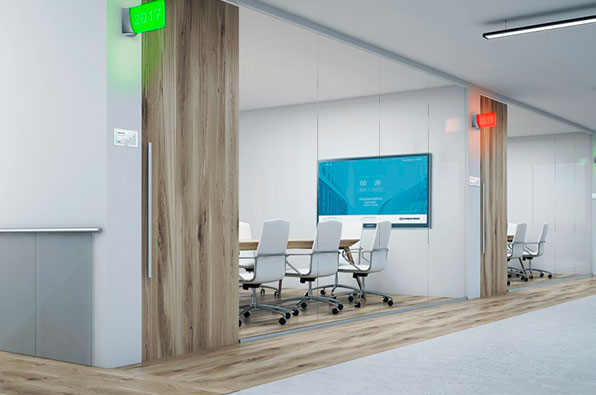Building Intelligence draws upon a refreshing convergence of workplace culture, health and wellness, architecture, and smart cities.



A Single Pane of Glass
You’re an employee who needs to find a parking space fast, customize the temperature and lighting at your workspace, track your progress at the building gym, or find an open desk…
You run a business – you have a mobile, agile workforce spread across multiple floors, even buildings. You need to manage all kinds of space – open and unassigned, meeting and collaboration, hot-desking…
As a developer or manager of a large real estate portfolio or enterprises – you need one consolidated platform that can manage operations and proactive maintenance across a fleet of buildings or a campus…
There IS an App for all that, and much, much, more – but what lies between the hand-held and the light switch, or the equipment maintenance order? The “genius” of workplace mobility and connectivity is enabled by a comprehensive “Building Intelligence” infrastructure. Building technologies and services have come a long, long way since the early days of physically disparate systems with proprietary protocols and siloed system-by-system servers and dashboards – they can now be monitored and managed from a single-pane-of-glass.
So what is “Building Intelligence”, exactly, and why does it matter?
Whether for business or institutions, and other complex facilities, Building Intelligence (we’ve dubbed it “BI”), delivers multi-system monitoring and control through a combination of data collection and analytics, a software application running over a converged network, and an established set of protocols for the integration and workflow between systems.
BI aligns a building with the expectations and demands of ‘Globally Competent’ users – people with the knowledge, skill and disposition necessary to navigate and succeed in today’s interconnected world. Globally competent people expect sustainable and energy efficient buildings, autonomous control of their space and activities, and technologically advanced integrations similar to their homes and cars.
What really creates BI?
“It’s a common preconception that Intelligence in a Built Environment is simply the convergence of IP based building systems onto a common network”, says Mike Prsa, Principal and Building Intelligence Lead at MBII. “Far from the truth, as this level of technology has been the status quo now, for over a decade.”
It takes an established set of protocols to dictate information workflows to the various IP-based systems to enable them to integrate and intelligently exchange meaningful and actionable data – for multi-system monitoring and control purposes. Underpinning this confusing array of data analytics, software applications, converged networks, and protocols, are four key “pillars” of Building Intelligence, each with their own acronym – Data, FDD, UUI, and PR.
The key differentiator, or, what really creates Building Intelligence, is the extrapolation of data from any array of building systems plus IoT (Internet of Things) devices. Analytics are run across the data set in a multitude of “if, then” iterations to create a cause and effect matrix – the causes are defined, and the effects are only limited by the imagination and the wallet.
All good, but how is ROI gaged, how is it measured? Investing in BI has qualitative & quantifiable results- we call it “The Four C’s”: Capacity, Comfort, Cost, Consumption
When full BI is leveraged in accordance with the four “pillars” and “The Four C’s”, real savings are realized – stats are now reporting 12% – 25% in energy savings, with 2-3 year paybacks now possible.
…BUT there is more at stake – an investment in BI suits the mission for a building with a forward looking live/work culture that both owners and occupants can be invested in. Around the globe, developers are recognizing the leverage of BI, to substantially differentiate their building – customize it to variables of location, climate, culture, urbanity, transit connectivity, and occupation – by owner or tenant(s).
There are already solid global precedents to cite – from “The Crowne” in Melbourne (with an energy savings of 1GWh within one year), to the University of Iowa (energy savings of $600K, within 6 months, with 7,000 pieces of equipment monitored), not to mention the Edge, Amsterdam which some still consider to be the ‘most intelligent building in the world’.
Heads up… a forward thinking Canadian project is poised to show some strong leadership on the BI front – MBII project Vancouver Centre II (now in construction), being developed by GWL Realty Advisers. Not only will the 33-storey amenity rich tower pursue LEED® Platinum certification, it will also be designed to WELL Building Standard™, and be retail and transit connected – all tied together by a high level of Building Intelligence. A ‘single-pane-of-glass’ management platform will encompass Multiple User Levels (owner-to-guest), Fault Detection & Diagnostics, Alarm & Systems Data Analytics, Automated Smart LED Lighting platforms, and a dedicated building App.
Beyond attracting and retaining forward-thinking companies as tenants, public relations opportunities abound for the savvy owner/ developer, ie: provide self-enrollment that allows tenants to identify themselves, create a profile, and save comfort settings; assist facility managers in addressing tenant issues and taking cost saving actions like reducing energy usage; enable faster communication between facility managers and tenants to troubleshoot issues; engage tenants through community management features and health and wellness initiatives. If you really get hooked, there are even BI communities to join. A new paradigm perhaps, with an encouraging breadth of examination into how to make a more engaging and sustainable building.
Mike Prsa, P. Eng., is a Principal and Vice President at MBII, leading the Building Intelligence Design division. Reach him at 416-751-2122 extn. 269 or mprsa@mbii.com